Garryowen
Custer Museum’s rare Lewis and Clark exhibit may top Smithsonian display
Big Horn County News June 17, 2004 #24 vol. 97 By Carl Reickmann
Perhaps the most significant grouping of rare early-edition
publications chronicling the1803-06 Lewis and Clark Corps of Discovery reposes
not in the Smithsonian Institute but on a piece of the battlefield where Lt.
Col. George Custer and members of his 7th Cavalry discovered too many
attack-wise Indians. Odd as it may seem, that the new exhibit at the small
Custer Battlefield Museum at Garryowen may be a touch better than one producible
at the government’s famed and mighty Smithsonian occurs because it includes
the personal hand – notated and signed set belonging to the editor of the
first officially authorized publication of the journal notes of Meriwether Lewis
and William Clark.
 This seeming
quirk of location is due to the zeal and dedication for collecting American
historical memorabilia of Chris Kortlander, owner of the exhibit and also
director of the battlefield museum. “ What makes this so spectacular is that
most of the important rare books relating to the historical Lewis and Clark
expedition are now on display,” says Kortlander.
“I think it’s important for people to know that we have these in our
state.” Beside the Biddle set (the British edition published in 1815), the
exhibit includes the official 1814- published American edition, the
1811-published journal of expedition member Sgt. Patrick Gass, a cobbled-
together and 1809 published “counterfeit” description of the journey, an
original document signed by Clark and a peace pipe believed to be to linked to
the trek. The truly unique British
set belonged to Nicholas Biddle, the first president of the Bank of the United
States of America under President Thomas Jefferson and administrator and
editor-publisher of the official version of the journals that appeared in 1814,
with editing help from Paul Allen. Beyond Biddle’s personal set, only less than 30 of these
first editions sets are known still to exist, Kortlander says.
“He was hand-picked by Jefferson to help coordinate the financial
matters of the trek,” notes the director.
“These are Nicholas Biddle’s personal copies with original
hand-written notes, newspaper articles and originally autographed twice.
This is the only set owned by the publisher.”
Moreover, it includes the first government-produced images of Lewis and
Clark, original steel plate engravings commissioned by the U.S. Treasury.
This seeming
quirk of location is due to the zeal and dedication for collecting American
historical memorabilia of Chris Kortlander, owner of the exhibit and also
director of the battlefield museum. “ What makes this so spectacular is that
most of the important rare books relating to the historical Lewis and Clark
expedition are now on display,” says Kortlander.
“I think it’s important for people to know that we have these in our
state.” Beside the Biddle set (the British edition published in 1815), the
exhibit includes the official 1814- published American edition, the
1811-published journal of expedition member Sgt. Patrick Gass, a cobbled-
together and 1809 published “counterfeit” description of the journey, an
original document signed by Clark and a peace pipe believed to be to linked to
the trek. The truly unique British
set belonged to Nicholas Biddle, the first president of the Bank of the United
States of America under President Thomas Jefferson and administrator and
editor-publisher of the official version of the journals that appeared in 1814,
with editing help from Paul Allen. Beyond Biddle’s personal set, only less than 30 of these
first editions sets are known still to exist, Kortlander says.
“He was hand-picked by Jefferson to help coordinate the financial
matters of the trek,” notes the director.
“These are Nicholas Biddle’s personal copies with original
hand-written notes, newspaper articles and originally autographed twice.
This is the only set owned by the publisher.”
Moreover, it includes the first government-produced images of Lewis and
Clark, original steel plate engravings commissioned by the U.S. Treasury.
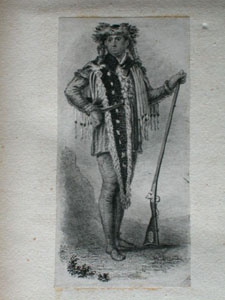 A Biddle notation in the
book: “The vignette portraits at the end of the English preface are from
banknote proofs engraved by Toppan: Gov. Clark is said to be a good likeness.”
The director says Biddle borrowed them from Treasury and tipped them into
his personal copy, which also included contemporary newspaper clippings about
the deaths of Lewis and Clark. The
peace pipe is a curious enigma. A
display description invites viewers to wonder if the item might have been on the
historic expedition, for hand-carved on its soapstone bowl and ash-wood stem are
the names of Gass, Sacajawea and a British Dr. McTavish who is recorded as
visiting the expedition as it wintered on the Oregon coast.
Also carved are two birds, a male bust, a male and female elk and the
year “1806” twice. The exhibit’s so-called “Apocrypha” is the first
published account of the Lewis and Clark trek.
Compiled by Hubbard Lester, it began to appear in 1809.
“Published and assembled without permission, it was declared
counterfeit,” explains Kortlander. “Lester relied on letters and reports from other sources.
However, it did serve to whet the public appetite for the great
adventure.” On his title page,
Lester promises all the scoop about the expedition “from various authentic
sources and documents (including) from the Official Communication of Meriwether
Lewis, “It was published in Philadelphia for $1.69.
Historical editor Donald Jackson says Lester’s book was based partly on
the Gass journal, two Clark letters, data about some Indian tribes by British
trader Alexander MacKenzie, a statistical view on tribes by Lewis, extracts from
a Jefferson message, “an essay of Jonathan Carver’s published without credit
to the author and some miscellany.” Kortlander’s
1811 copy of the Gass journal has some expedition sketches (not by Gass), is
leather-bound and cost about $1 in November 1811.
A Biddle notation in the
book: “The vignette portraits at the end of the English preface are from
banknote proofs engraved by Toppan: Gov. Clark is said to be a good likeness.”
The director says Biddle borrowed them from Treasury and tipped them into
his personal copy, which also included contemporary newspaper clippings about
the deaths of Lewis and Clark. The
peace pipe is a curious enigma. A
display description invites viewers to wonder if the item might have been on the
historic expedition, for hand-carved on its soapstone bowl and ash-wood stem are
the names of Gass, Sacajawea and a British Dr. McTavish who is recorded as
visiting the expedition as it wintered on the Oregon coast.
Also carved are two birds, a male bust, a male and female elk and the
year “1806” twice. The exhibit’s so-called “Apocrypha” is the first
published account of the Lewis and Clark trek.
Compiled by Hubbard Lester, it began to appear in 1809.
“Published and assembled without permission, it was declared
counterfeit,” explains Kortlander. “Lester relied on letters and reports from other sources.
However, it did serve to whet the public appetite for the great
adventure.” On his title page,
Lester promises all the scoop about the expedition “from various authentic
sources and documents (including) from the Official Communication of Meriwether
Lewis, “It was published in Philadelphia for $1.69.
Historical editor Donald Jackson says Lester’s book was based partly on
the Gass journal, two Clark letters, data about some Indian tribes by British
trader Alexander MacKenzie, a statistical view on tribes by Lewis, extracts from
a Jefferson message, “an essay of Jonathan Carver’s published without credit
to the author and some miscellany.” Kortlander’s
1811 copy of the Gass journal has some expedition sketches (not by Gass), is
leather-bound and cost about $1 in November 1811.
Big
Horn County News, June 24, 2004 #25 vol. 98 By Carl Reickmann, Part 2
The travel of the details of the famed expedition to the
printed page is a soap opera in itself.
Lewis set off with good intentions to publish his journals
after the fanfare following return of the corps, but he knew he needed help to
get the job done. He set about making arrangements for aid on the naturalistic
part of his gathered data and connected with publisher-bookseller John Conrad of
Philadelphia to make a commitment and work up a formal prospectus to advertise
the coming volumes.
His dismay at the thought of other trek journals or
accounts coming out before his was reflected in his public notice in the
National Intelligencer on March 14, 1807.
“Having been informed that there were several
unauthorized and probably some spurious publications now preparing for the press
(on the expedition) by individuals entirely unknown to me, I have considered it
a duty which I owe the public, as well as myself, to put them on their
guard…lest from the practice of such impositions they may be taught to
depreciate the worth of the work which I am myself preparing for publication
before it can possibly appear, as much time, labor and expense are absolutely
necessary in order to do justice to the several subjects which it will
embrace,” Lewis wrote.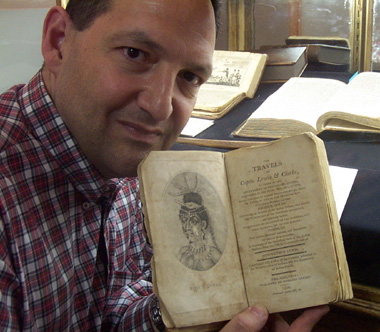
Instead, he suggested readers subscribe for the upcoming
publication of his intended three-volume work (the first book by Jan. 1, 1808
and the other two soon thereafter) “to prevent the practice of those
deceptions.”
Lewis said only Robert Frazier had been given permission by
Clark or himself to publish anything about the “late voyage,” an OK that he
was rescinding upon seeing a Frazier prospectus promising natural history
details that seemed to overreach his understanding level.
“(Frazier) was only a private on this expedition, is
entirely unacquainted with celestial observations, mineralogy, botany or zoology
and therefore cannot possibly give any accurate information on those subjects,
nor on that of geography, and that the whole which can be expected from his
Journal is merely a limited detail of our daily transactions,” the explorer
affirmed.
“With respect to all unauthorized publications relative
to this voyage, I presume that they cannot have stronger pretensions to accuracy
of information than that of (Frazier).”
On March 23, Pittsburgh bookseller David McKeehan printed a
proposal for the Gass journal as a nearly 300-page work that would cost $1.00,
with a 12.5-cent discount to those who ordered early and a free copy to anyone
drumming up 10 other subscribers.
McKeehan used a glowing Lewis testimonial of Gass (that
Lewis wrote for all of his men) commending him with “highest confidence and
sincere thanks.”
And by April 7, McKeehan is blasting Lewis in an open
letter printed in the Pittsburgh Gazette for his rebuking criticism of Frazier
and other would-be publishing journalists. He accused Lewis of becoming
swell-headed and greedily trying to keep the value of his own upcoming work from
depreciating.
“I am afraid Captain Clarke, who appears to have acted
during the whole of the tour with the greatest prudence, firmness and courage,
will be forced to blush for the man he has called his friend,” the bookseller
ragged.
He wondered by what right Lewis could decide what was
authorized about “my tour” when it was a government-paid operation.
“I’ll squeeze the nation first and then raise a heavy
contribution on the citizens individually; I’ll cry down these one-volume
journals and frighten the publishers; and no man, woman or child shall read a
word about my tour, unless they enter their names on my lists and pay what price
I shall afterwards fix on my three volumes and map,” McKeehan suggested as the
Lewis mindset.
In stabs at humor at the expense of Lewis, McKeehan even
supposed that the accidental bullet wound to his rear end by Pierre Cruzatte
while hunting on the trip may have been by design – “that the young hero
might not return without more scars (if not honorable, near the place of honour)
to excite the curiosity and compassion of some favorite widow…who might have
been languishing during his absence.”
And thus headed Lewis for St. Louis to take over duties as
Jefferson’s new governor for the Louisiana Territory – and any further
progress by Lewis on the project never seemed to materialize, despite urgings
from Conrad, Jefferson, Clark and others.
All indications are that he got bogged down by the
difficulties of being governor, his personal running skirmish with his jealous
territorial secretary (Frederick Bates), his deepening financial woes as the War
Department questioned many of his expenditures and claims from the expedition as
well as during his tenure in St. Louis and a seeming onslaught of health
problems, including heavy drinking and probably severe depression.
He was not answering mail from Jefferson or his publisher,
causing the president at one point to observe to War Secretary William Dearborn:
“It is astonishing we get not one word from him.”
“The cause almost surely was Lewis’ chagrin at failing
to prepare his manuscript for the printer,” historian Stephen Ambrose writes.
“He knew how much it meant to Jefferson. He further knew how much it meant to
his own financial future and to his reputation. Yet, he did nothing.”
Ambrose suggests Lewis might have told Jefferson he was too
busy as governor and confessed, Jefferson perhaps could have helped by putting
some government clerks to work on his notes. Jefferson even wrote to him in
August 1809 that “I have so long promised copies to my literary correspondents
in France that I am almost bankrupt in their eyes.”
Lewis’ behavior had became erratic.
By September 1809, Lewis and Clark both decided to travel
to Washington to discuss matters with the War Department, including protested
bills from Lewis. Lewis also told Clark he would go to Philadelphia to get the
publication process started.
But Lewis, with his journals and other belongings, set off
toward New Orleans for a water trip, and Clark was to travel by land. They never
saw one another again.
Lewis’ journey behavior included drinking, pill-popping
and two reported suicide attempts. He wrote a will on Sept. 11 in favor of his
mother. He was placed under observation and recuperation at Fort Pickering
(present-day Memphis)
He told lies, including advising fort commander Capt.
Gilbert Russell that all the work on his journals was complete and ready for the
press. When deemed ready to travel again, he decided an overland trip via the
Natchez Trace was safer with the journals rather than an ocean boat ride
susceptible to British confiscation of the journals.
Near present-day Nashville, at Grinder’s Inn, he
apparently shot and razored himself to death, leaving the task of seeing the
journals into print to Clark and Jefferson.
Upon learning of Lewis’ death, his publishers asked
Jefferson what to do now. “(Lewis) never furnished us with a line of the
(manuscript),” they said.
There was talk about Jefferson taking over the project,
with Clark going to see the publishers to discuss the situation. But the former
president was 65 years old and wished to spend his remaining years as a
gentleman farmer.
After some effort, Clark convinced Nicholas Biddle, then a
26-year-old prodigy admitted to the University of Pennsylvania at age 10 and
awarded a Princeton University degree at age 15, to take over the project.
Biddle, who married one of the richest women in the country, took nothing for
more than two years of full-time labor on the project and hired Paul Allen to do
some copyediting for $500.
Biddle’s published proposal of May 1810 lamented the
delay caused by the death of Lewis and other factors.
“This delay, although it has disappointed the public
expectation and given rise to several imperfect accounts of the journey, may be
the less regretted, as the residence of both Captains Lewis and Clarke in
Louisiana has enabled them greatly to extend and mature their knowledge of the
country which they describe,” Biddle announced.
But when Biddle was ready to turn over the narrative volume
to the printer, the War of 1812 broke out, and the firm of C. and A. Conrad of
Philadelphia collapsed. Knowing “the work will lose some of its interest by so
much delay,” it took him more than a year to find Bradford and Inskeep of
Philadelphia as new publishers. 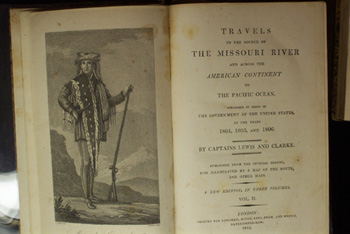
The 1814 volumes is a narrative and paraphrase of the
journals, true to the original but with corrected spellings. And Biddle did
little with the flora and fauna because the expert recruited by Biddle could not
complete that task when his health failed.
Initially, 1,417 copies of the narrative were printed and
priced at $6 each. They sold slowly, with the Gass and other versions out.
For 90 years, the Biddle edition was the only printed
account based on the journals, which means Lewis and Clark got little credit or
notoriety for most of their discoveries. Places, animals, plants and birds they
discovered were “rediscovered” by others, who gave them the names that
stuck.
Biddle’s name appears printed nowhere in his edition, for
he apparently favored anonymity, giving Paul Allen the “prepared for press
by” nod on the title page. And Lewis became almost forgotten over the years,
while Clark was more remembered for work as follow-up Louisiana Territory
governor.
Until 1901, when the government created the $10 “Buffalo
Bill” with Lewis and Clark on it to create interest for the upcoming Lewis and
Clark Centennial Exposition at Portland, Ore., and 1904, when Reuben Gold
Thwaites of the Wisconsin State Historical Society published (in eight volumes)
the complete original journals, including never-prior-seen journals from two of
the enlisted men.
Thwaites’ work is the definitive scholarly treatment and
most quoted, supplemented in 1962 by Donald Jackson’s footnoted collection of
letters relating to the expedition and Gary Moulton’s 1980s treatment of the
journals with expanded new material and more emphasis on botany and other
scientific subjects.
Jefferson ordered from Biddle 13 bound and hardboard copies
of the edition. And Clark, by 1821, is writing to Biddle to see if he can gain
anything from the publishers for the book and, also importantly, if he can get
any copies of the book.
“If any Books are recovered for me, please send a Copy to
me as but few are to be met with in this country & none to purchase & I
have never found any,” Clark explains.
Clark would not be surprised they still are rare today.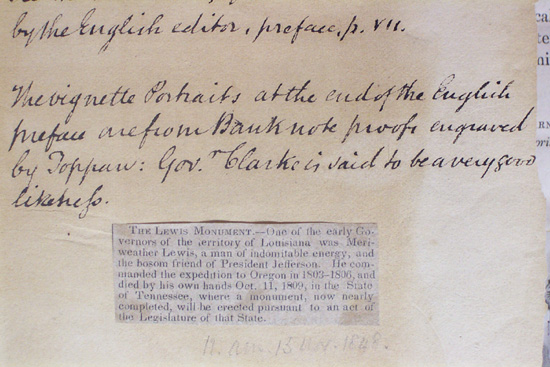
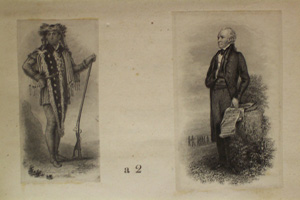
 This seeming
quirk of location is due to the zeal and dedication for collecting American
historical memorabilia of Chris Kortlander, owner of the exhibit and also
director of the battlefield museum. “ What makes this so spectacular is that
most of the important rare books relating to the historical Lewis and Clark
expedition are now on display,” says Kortlander.
“I think it’s important for people to know that we have these in our
state.” Beside the Biddle set (the British edition published in 1815), the
exhibit includes the official 1814- published American edition, the
1811-published journal of expedition member Sgt. Patrick Gass, a cobbled-
together and 1809 published “counterfeit” description of the journey, an
original document signed by Clark and a peace pipe believed to be to linked to
the trek. The truly unique British
set belonged to Nicholas Biddle, the first president of the Bank of the United
States of America under President Thomas Jefferson and administrator and
editor-publisher of the official version of the journals that appeared in 1814,
with editing help from Paul Allen. Beyond Biddle’s personal set, only less than 30 of these
first editions sets are known still to exist, Kortlander says.
“He was hand-picked by Jefferson to help coordinate the financial
matters of the trek,” notes the director.
“These are Nicholas Biddle’s personal copies with original
hand-written notes, newspaper articles and originally autographed twice.
This is the only set owned by the publisher.”
Moreover, it includes the first government-produced images of Lewis and
Clark, original steel plate engravings commissioned by the U.S. Treasury.
This seeming
quirk of location is due to the zeal and dedication for collecting American
historical memorabilia of Chris Kortlander, owner of the exhibit and also
director of the battlefield museum. “ What makes this so spectacular is that
most of the important rare books relating to the historical Lewis and Clark
expedition are now on display,” says Kortlander.
“I think it’s important for people to know that we have these in our
state.” Beside the Biddle set (the British edition published in 1815), the
exhibit includes the official 1814- published American edition, the
1811-published journal of expedition member Sgt. Patrick Gass, a cobbled-
together and 1809 published “counterfeit” description of the journey, an
original document signed by Clark and a peace pipe believed to be to linked to
the trek. The truly unique British
set belonged to Nicholas Biddle, the first president of the Bank of the United
States of America under President Thomas Jefferson and administrator and
editor-publisher of the official version of the journals that appeared in 1814,
with editing help from Paul Allen. Beyond Biddle’s personal set, only less than 30 of these
first editions sets are known still to exist, Kortlander says.
“He was hand-picked by Jefferson to help coordinate the financial
matters of the trek,” notes the director.
“These are Nicholas Biddle’s personal copies with original
hand-written notes, newspaper articles and originally autographed twice.
This is the only set owned by the publisher.”
Moreover, it includes the first government-produced images of Lewis and
Clark, original steel plate engravings commissioned by the U.S. Treasury.
 A Biddle notation in the
book: “The vignette portraits at the end of the English preface are from
banknote proofs engraved by Toppan: Gov. Clark is said to be a good likeness.”
The director says Biddle borrowed them from Treasury and tipped them into
his personal copy, which also included contemporary newspaper clippings about
the deaths of Lewis and Clark. The
peace pipe is a curious enigma. A
display description invites viewers to wonder if the item might have been on the
historic expedition, for hand-carved on its soapstone bowl and ash-wood stem are
the names of Gass, Sacajawea and a British Dr. McTavish who is recorded as
visiting the expedition as it wintered on the Oregon coast.
Also carved are two birds, a male bust, a male and female elk and the
year “1806” twice. The exhibit’s so-called “Apocrypha” is the first
published account of the Lewis and Clark trek.
Compiled by Hubbard Lester, it began to appear in 1809.
“Published and assembled without permission, it was declared
counterfeit,” explains Kortlander. “Lester relied on letters and reports from other sources.
However, it did serve to whet the public appetite for the great
adventure.” On his title page,
Lester promises all the scoop about the expedition “from various authentic
sources and documents (including) from the Official Communication of Meriwether
Lewis, “It was published in Philadelphia for $1.69.
Historical editor Donald Jackson says Lester’s book was based partly on
the Gass journal, two Clark letters, data about some Indian tribes by British
trader Alexander MacKenzie, a statistical view on tribes by Lewis, extracts from
a Jefferson message, “an essay of Jonathan Carver’s published without credit
to the author and some miscellany.” Kortlander’s
1811 copy of the Gass journal has some expedition sketches (not by Gass), is
leather-bound and cost about $1 in November 1811.
A Biddle notation in the
book: “The vignette portraits at the end of the English preface are from
banknote proofs engraved by Toppan: Gov. Clark is said to be a good likeness.”
The director says Biddle borrowed them from Treasury and tipped them into
his personal copy, which also included contemporary newspaper clippings about
the deaths of Lewis and Clark. The
peace pipe is a curious enigma. A
display description invites viewers to wonder if the item might have been on the
historic expedition, for hand-carved on its soapstone bowl and ash-wood stem are
the names of Gass, Sacajawea and a British Dr. McTavish who is recorded as
visiting the expedition as it wintered on the Oregon coast.
Also carved are two birds, a male bust, a male and female elk and the
year “1806” twice. The exhibit’s so-called “Apocrypha” is the first
published account of the Lewis and Clark trek.
Compiled by Hubbard Lester, it began to appear in 1809.
“Published and assembled without permission, it was declared
counterfeit,” explains Kortlander. “Lester relied on letters and reports from other sources.
However, it did serve to whet the public appetite for the great
adventure.” On his title page,
Lester promises all the scoop about the expedition “from various authentic
sources and documents (including) from the Official Communication of Meriwether
Lewis, “It was published in Philadelphia for $1.69.
Historical editor Donald Jackson says Lester’s book was based partly on
the Gass journal, two Clark letters, data about some Indian tribes by British
trader Alexander MacKenzie, a statistical view on tribes by Lewis, extracts from
a Jefferson message, “an essay of Jonathan Carver’s published without credit
to the author and some miscellany.” Kortlander’s
1811 copy of the Gass journal has some expedition sketches (not by Gass), is
leather-bound and cost about $1 in November 1811.




